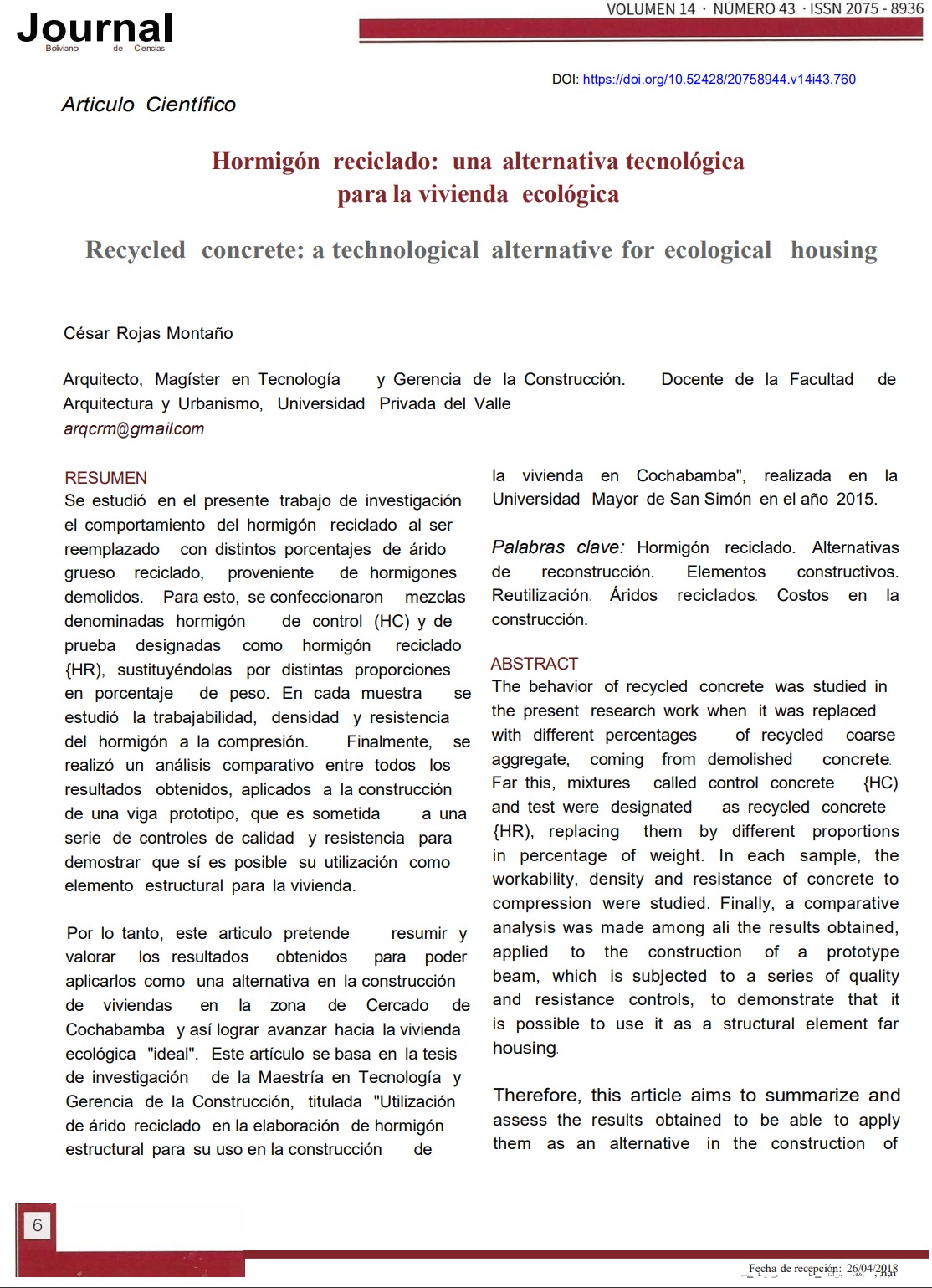Recycled Concrete: a Technological Alternative for Ecological Housing
DOI:
https://doi.org/10.52428/20758944.v14i43.760Keywords:
Recycled Concrete, Construction Alternatives, Constructive Elements, Reuse, Recycled Arid, Construction CostsAbstract
The behavior of recycled concrete was studied in the present research work when it was replaced with different percentages of recycled coarse aggregate, coming from demolished concrete. For this, mixtures called control concrete (HC) and test were designated as recycled concrete (HR), replacing them by different proportions in percentage of weight. In each sample, the workability, density and resistance of concrete to compression were studied. Finally, a comparative analysis was made amongall the resultsobtained, applied to the construction of a prototype beam, which is subjected to a series of quality and resistance controls, to demonstrate that it is possible to use it as a structural element for housing. Therefore, this article aims to summarize and assess the results obtained to be able to apply them as an alternative in the construction of houses in the area of Cercado de Cochabamba and thus achieve progress towards the "ideal" ecological housing. This article is based on the research thesis of the Master in Technology and Construction Management, entitled "Use of recycled aggregate in the production of structural concrete for use in the construction of housing in Cochabamba", carried out at the University Mayor of San Simón in 2015.
Downloads
References
Estrela, E. (2012). Las 3-5 erres: reutilizar, reducir, reparar, reciclar y regular. España: Hablando de ciencia. Recupera do de: http://www.hablandodeciencia.com/articulos/2012/10/18/las5-erres-reutiIizarreducir-reparar-reciclar-y-regular/
Rodríguez, G. (2010). La generación de residuos sólidos de obras civiles del área urbana de Cochabamba por zonas y distritos. Cochabamba, Bolivia: SGAB. Pag. 20-35-41.
López, F. (2008). Influencia de la variación de los parámetros de dosificación y fabricación de hormigón reciclado estructural sobre sus propiedades físicas y mecánicas. Tesis para optar al grado de Doctor, Real Universidad de España. Ciudad de Gijón, España. p. 158
Redacción Central (2011). Precios de materiales se elevan. Cochabamba, Bolivia: Los Tiempos. Recuperado de: http://www.lostiempos.com/actualidad/economia/20110605/precios-materiales-seelevan
Instituto Nacional de Estadistica (2011). Censo Nacional de Población y Vivienda 2012. Bolivia: Publicación Cartillas INE. p.7-8.
Sociedad de Gestión Ambiental Boliviana (2011). La generación de residuos sólidos de obras civiles del área urbana de Cochabamba. Bolivia: SGAB. p. 8
Universidad Mayor de San Simón (2005). Lnundaciones en el valle de Cochabamba, impactos ambientales y efectos socio económicos Cochabamba: UMSS.
Guijarro, C. (2008). Influencia de variación de parámetros de dosificación, para hormigones reciclados. Tesis para optar al grado de Doctor. Universidad de Oviedo, España. Pag. 16.
Universidad de la Plata (2009). Manual de Directrices para et Uso de Áridos Reciclados en Obras Públicas de la Comunidad. Argentina: Editorial La Plata.
Avenburg, E. (1972). Resistencia de materiales. Buenos Aires, Argentina: Ediciones Pannedille.
Chandias, M. y Ramos, JM. (2004). Cómputos y presupuesto. (19va Ed.). Buenos Aires, Argentina: Editorial Alsina.
Gaceta Oficial De Bolivia (1992). Reglamento Ley N° 1333 del medio ambiente, gestión de residuos sólidos. La Paz, Bolivia: Honorable Congreso Nacional.
Gobierno Autónomo Municipal De Cochabamba (2002). Reglamento Municipal para la gestión integral de residuos sólidos domiciliarios y asimilables, O.M. 2861/02. Cochabarnba, Bolivia: GAMC
Martinel, A. (2007). Los residuos sólidos, como potencial del desarrollo económico local, Concurso RIDELC. Cocha bamba, Bolivia: RIDELC.
Ministerio De Medio Ambiente y Aguas (2010). Guía Técnica para el Aprovechamiento de Áridos en Cauces de Rios y Afluentes. La Paz, Bolivia: Ministerio De Medio Ambiente y Agua.
Jiménez, P., García, A. y Morán F. (2011). Hormigón armado. (lSva Ed.). Barcelona, España: Editorial Gustavo Gilí.
Rodríguez, G. (2010). La generación de residuos sólidos de obras civiles del área urbana de Cochabamba por zonas y distritos. Estudio diagnóstico SGAB. Cochabamba, Bolivia: SGAB
Salvador, P. (200S). La Planificación verde de las ciudades. (lera ed. 2da tirada) Barcelona: España: Editorial Gustavo Gilí SA.

Downloads
Published
How to Cite
Issue
Section
License
Copyright (c) 2018 César Rojas Montaño

This work is licensed under a Creative Commons Attribution 4.0 International License.
Authors who publish with this journal agree to the following terms:
- Authors retain copyright and grant the journal right of first publication with the work simultaneously licensed under a Creative Commons Attribution License 4.0 that allows others to share the work with an acknowledgement of the work's authorship and initial publication in this journal.
- Authors are able to enter into separate, additional contractual arrangements for the non-exclusive distribution of the journal's published version of the work (e.g., post it to an institutional repository or publish it in a book), with an acknowledgement of its initial publication in this journal.
- Authors are permitted and encouraged to post their work online (e.g., in institutional repositories or on their website) prior to and during the submission process, as it can lead to productive exchanges, as well as earlier and greater citation of published work.














